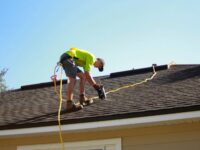The following contribution is from another author.
When you begin a residential business in a newly bought building, its maintenance is the furthest thing from your mind. It takes years for a building to age, after all. But if it has been home to generations of tenants, then it’s bound to have worn down through time. Without proper maintenance, it also has the chance to fall into disrepair.
That is why owners should do periodic maintenance on their property, despite seeing no evidence of deterioration. Proper maintenance will lead to a stronger building and slow down its aging. This will lead to fewer hassles in the long run and reduce the need for major repairs.
To help you get started, here is a list of what to pay attention to when conducting building maintenance.
Check Your Foundations
Take a look at the condition of your building. If the paint has faded out, it might be time for a new paint job. Prepare properly and thoroughly, and start by clearing out the part of the building that you intend to paint. Clean the walls and check for any portions that need to be filled or smoothed out. After doing these preparations, the repainting will not only be easier but also look better.
You will also need to check your roof for any holes, dents, or loose screws and repair them accordingly. You can also take this as a chance to repair or replace any weakening roof fasteners. Choosing the right fasteners for your building will minimize any future structural damage your building may experience. For example, if your components are mostly made of wood, timber roofing screws would serve you better in the long run.
Conduct Pest Control
No matter how clean a property is, small critters still have a chance of wandering in. Even if you are confident that you have no pests in your property, remember that preventing an infestation is more important. Periodic extermination will take care of any errant insects or rodents that happen to get inside. Make sure to conduct the extermination on the whole property to expel all pests fully.
Although frequent exterminations can be a bit pricey, keep in mind that full-scale extermination will incur more costs. Also, it will not only drive away current tenants but also deter any prospective ones. That is why these small constant costs are preferable to avoid a higher price and loss in long-term profit. This will also give you and your tenants peace of mind.
Inspect the Interior
Everyday things to look out for will be water damage or leaks. The best time to check would be after rain or snow so that you can see if water has slipped in. Check nooks and crannies, such as the underside of sinks and toilets. Make sure to repair and drain these immediately to avoid the production of mold.
It is also important to check on the water heater and ensure that the thermostat is still set at the right temperature. See to it that the temperature-pressure valve is functioning properly and that the anode rod is still in good shape. Don’t forget to flush it at least once a year to remove sediment particles. If left unchecked, these can clog up your drain and call for an expensive replacement.
Make sure the building is completely safe with double security steel doors to protect your building against forced entry. They can help increase the security of your entry point and help you meet any building regulatory requirements.
Building maintenance is something that you can’t slack off. You’ll save up on possible repair or replacement costs, which usually happens due to poor upkeep. Although it seems bothersome to do periodically, the long-term benefits will be better for you.
















